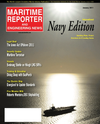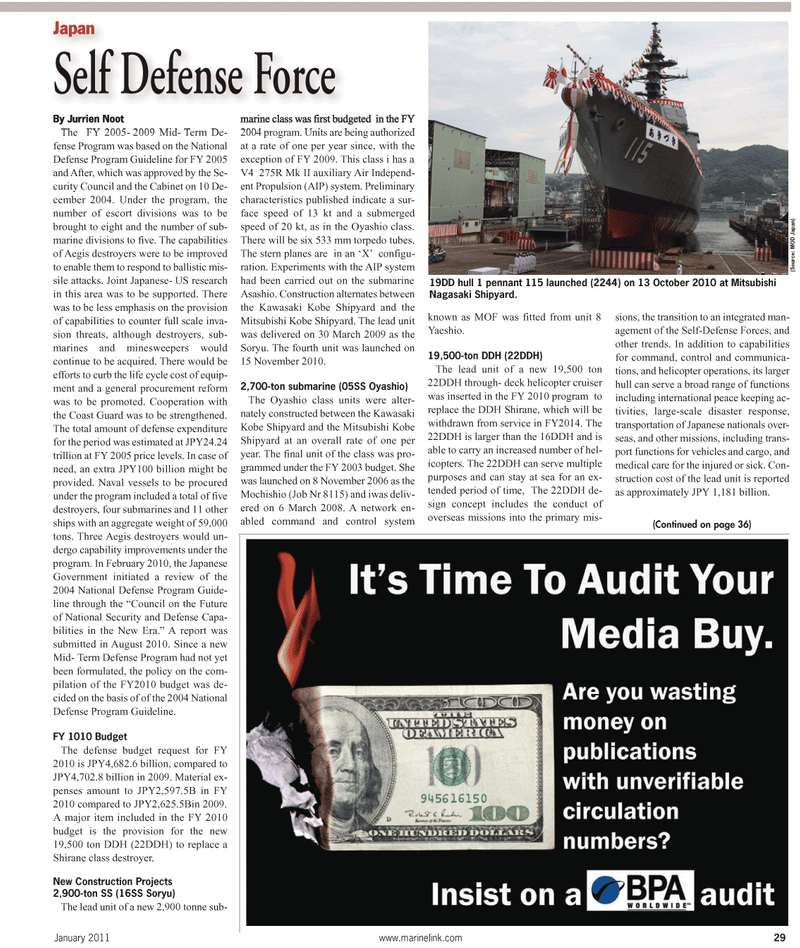
Page 29: of Maritime Reporter Magazine (January 2011)
International Naval Technology
Read this page in Pdf, Flash or Html5 edition of January 2011 Maritime Reporter Magazine
By Jurrien Noot
The FY 2005- 2009 Mid- Term De- fense Program was based on the National
Defense Program Guideline for FY 2005 and After, which was approved by the Se- curity Council and the Cabinet on 10 De- cember 2004. Under the program, the number of escort divisions was to be brought to eight and the number of sub- marine divisions to five. The capabilities of Aegis destroyers were to be improved to enable them to respond to ballistic mis- sile attacks. Joint Japanese- US research in this area was to be supported. There was to be less emphasis on the provision of capabilities to counter full scale inva- sion threats, although destroyers, sub- marines and minesweepers would continue to be acquired. There would be efforts to curb the life cycle cost of equip- ment and a general procurement reform was to be promoted. Cooperation with the Coast Guard was to be strengthened.
The total amount of defense expenditure for the period was estimated at JPY24.24 trillion at FY 2005 price levels. In case of need, an extra JPY100 billion might be provided. Naval vessels to be procured under the program included a total of five destroyers, four submarines and 11 other ships with an aggregate weight of 59,000 tons. Three Aegis destroyers would un- dergo capability improvements under the program. In February 2010, the Japanese
Government initiated a review of the 2004 National Defense Program Guide- line through the “Council on the Future of National Security and Defense Capa- bilities in the New Era.” A report was submitted in August 2010. Since a new
Mid- Term Defense Program had not yet been formulated, the policy on the com- pilation of the FY2010 budget was de- cided on the basis of of the 2004 National
Defense Program Guideline.
FY 1010 Budget
The defense budget request for FY 2010 is JPY4,682.6 billion, compared to
JPY4,702.8 billion in 2009. Material ex- penses amount to JPY2,597.5B in FY 2010 compared to JPY2,625.5Bin 2009.
A major item included in the FY 2010 budget is the provision for the new 19,500 ton DDH (22DDH) to replace a
Shirane class destroyer.
New Construction Projects 2,900-ton SS (16SS Soryu)
The lead unit of a new 2,900 tonne sub- marine class was first budgeted in the FY 2004 program. Units are being authorized at a rate of one per year since, with the exception of FY 2009. This class i has a
V4 275R Mk II auxiliary Air Independ- ent Propulsion (AIP) system. Preliminary characteristics published indicate a sur- face speed of 13 kt and a submerged speed of 20 kt, as in the Oyashio class.
There will be six 533 mm torpedo tubes.
The stern planes are in an ‘X’ configu- ration. Experiments with the AIP system had been carried out on the submarine
Asashio. Construction alternates between the Kawasaki Kobe Shipyard and the
Mitsubishi Kobe Shipyard. The lead unit was delivered on 30 March 2009 as the
Soryu. The fourth unit was launched on 15 November 2010. 2,700-ton submarine (05SS Oyashio)
The Oyashio class units were alter- nately constructed between the Kawasaki
Kobe Shipyard and the Mitsubishi Kobe
Shipyard at an overall rate of one per year. The final unit of the class was pro- grammed under the FY 2003 budget. She was launched on 8 November 2006 as the
Mochishio (Job Nr 8115) and iwas deliv- ered on 6 March 2008. A network en- abled command and control system known as MOF was fitted from unit 8
Yaeshio. 19,500-ton DDH (22DDH)
The lead unit of a new 19,500 ton 22DDH through- deck helicopter cruiser was inserted in the FY 2010 program to replace the DDH Shirane, which will be withdrawn from service in FY2014. The 22DDH is larger than the 16DDH and is able to carry an increased number of hel- icopters. The 22DDH can serve multiple purposes and can stay at sea for an ex- tended period of time, The 22DDH de- sign concept includes the conduct of overseas missions into the primary mis- sions, the transition to an integrated man- agement of the Self-Defense Forces, and other trends. In addition to capabilities for command, control and communica- tions, and helicopter operations, its larger hull can serve a broad range of functions including international peace keeping ac- tivities, large-scale disaster response, transportation of Japanese nationals over- seas, and other missions, including trans- port functions for vehicles and cargo, and medical care for the injured or sick. Con- struction cost of the lead unit is reported as approximately JPY 1,181 billion.
Japan
Self Defense Force 19DD hull 1 pennant 115 launched (2244) on 13 October 2010 at Mitsubishi
Nagasaki Shipyard. (Sour ce: MOD Japan) (Continued on page 36)
January 2011 www.marinelink.com 29

 28
28

 30
30
